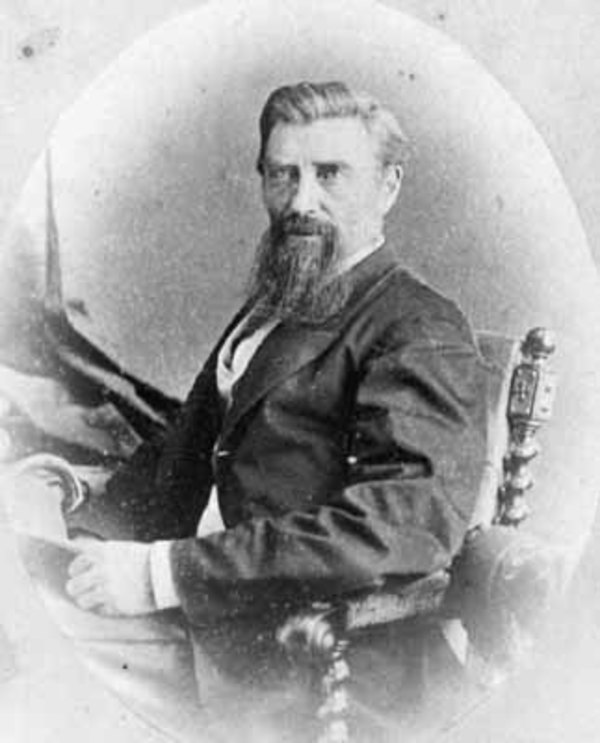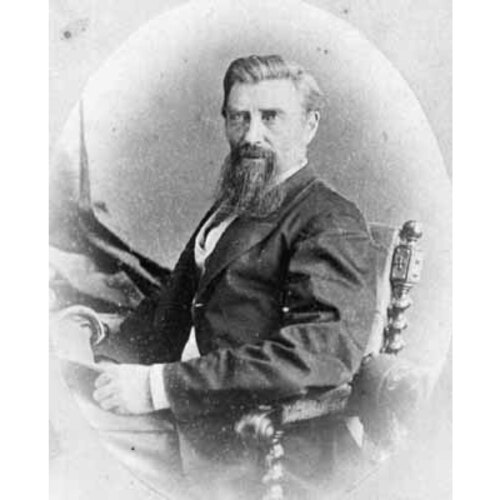
Source: Link
HARDISTY, RICHARD CHARLES, HBC furtrader and politician; b. c. 1832, probably at Fort Mistassini (Baie-du-Poste, Que.), fourth son of Richard Hardisty and Margaret Sutherland, and brother of William Lucas Hardisty; m. in 1866 Eliza, daughter of George Millward McDougall*, Methodist clergyman and missionary, and they had three children; d. 15 Oct. 1889 at Winnipeg, Man.
Richard Charles Hardisty’s father, a Hudson’s Bay Company chief trader, was a native of London, England, and his mother was of Indian and Scottish parentage. Hardisty spent nine years at the Red River Academy before joining the HBC in 1849 as an apprentice post master in the Red River District (Man.). Five years later he was appointed clerk and assumed charge of Cumberland House District (Sask.). This was a small district with only three posts, but it was a promotion for the “efficient young officer.” During the year that Hardisty served at Cumberland House he increased the returns by £250, which pleased Governor George Simpson*. From 1855 to 1861, Hardisty served at Carlton House (Sask.) where he had been sent to counteract increasing competition from free traders. In 1862 he was appointed chief trader and took charge of the Saskatchewan District during the temporary absence of Chief Factor William Joseph Christie*. Christie took a strong fatherly interest in Hardisty, encouraged him in his work, treated him as an assistant, and wrote him long informative letters closing with the paternal blessing, “May a kind Providence watch over & Protect you.”
In 1864 Christie sent Hardisty to re-establish Rocky Mountain House (Alta) which had been closed in 1861 because of the threatening attitude of the Blackfoot Indians. Hardisty built a new post and remained there until 1867 when he was transferred to Fort Victoria (now Pakan, Alta). Each spring he was sent to Carlton or Norway House (Man.) with the annual returns, and once back in Fort Edmonton supervised the trans-shipment of trade goods and supplies for the various posts before retiring to his own station.
Having been granted furlough for the 1869–70 season, Hardisty left Edmonton in April with his family, probably for Montreal. On 27 Dec. 1869, however, he arrived at Upper Fort Garry (Winnipeg) with his brother-in-law, Donald Alexander Smith*, a special commissioner from the government of Canada to the provisional government established by Louis Riel. The HBC fort had been seized by Riel and his party on 2 November, and when Hardisty and Smith were admitted to the fort by Riel they were put under house arrest. Smith had taken the precaution of leaving his official papers at Pembina (N. Dak.) to avoid any danger of their being confiscated by Riel. The Métis leader, interested in seeing Smith’s actual commission, gave Hardisty permission to travel to Pembina, escorted by two of his men, to collect Smith’s documents. Smith’s supporters did not trust Riel with regard to the papers; they had Hardisty intercepted on his return journey and escorted him to the fort. With Smith in possession of the documents, Riel was forced to recognize his official status and allow him to call a general meeting of the people in the Red River Settlement on 19 Jan. 1870 to state the views of the government of Canada about its future intentions towards the northwest. For Hardisty, who lacked neither courage nor stamina, the trip from Pembina to Scratching River (now Morris River) where he was intercepted, had been “as hard a one as he ever had experienced.”
With Smith, Hardisty left Upper Fort Garry on 19 March for eastern Canada but returned to Fort Victoria that fall. In 1872 he was made a chief factor and was appointed to the charge of the Upper Saskatchewan District with headquarters at Fort Edmonton. For the next 17 years Hardisty travelled his large district, ministering to the needs of Indians and settlers. They were years of constant change and adjustment. The Indians and Métis suffered because of the retreat of the buffalo, and were frequently bewildered by the results of treaty negotiations. Hardisty also realized that new fur-trading posts would not meet the competition of free traders. Instead, he closed unprofitable posts and proposed that the HBC buy furs from these traders. His abilities as a trader were unquestioned but he was not good at accounts, as a number of expressions of concern by HBC commissioners show.
Noting in 1882 that as many as 300 heads of families were arriving in the northwest in a year, Hardisty concentrated on the new settlements which were springing up close to the railways. To control the grain and timber market, he purchased a mill in 1881 with his own capital, and explained his actions to the HBC commissioner in Winnipeg, James Allan Grahame*, by saying “If Edmonton gets built up into a town as is expected, the sale of lumber will then come into play.” The HBC saw a conflict of interest here and Hardisty relinquished the mill at its request in 1885. To meet the competition of American traders who were swarming along the Bow River, in 1874 he had sent John Bunn to select a site for Bow Fort, 40 miles from modern Calgary.
In the first general election of 1887 for the District of Alberta, Hardisty ran as an independent after having been refused the Conservative nomination. Two points in his programme reveal his progressive thinking: he wanted the rights of the Métis upheld and a highway built between Edmonton and the Mackenzie River. Better known in the northern, less populated part of his constituency than in the south, he was defeated by his Conservative opponent, Donald Watson Davis.
In January 1888, while visiting England, Hardisty was appointed an acting inspector of the Northern Department of the HBC with an increase in salary of £100 per annum. On 23 Feb. 1888 he was called to the Senate of Canada, the first senator from the District of Alberta. He died in Winnipeg on 15 Oct. 1889 from injuries received when thrown from a buggy at Broadview (Sask.).
Glenbow-Alberta Institute, Richard Hardisty papers. PAC, MG 26, A. PAM, HBCA, A.1/177: f.57d; A.1/183: ff.92d, 103d; A.6/37: f.59d; A.6/57: f.605; A.11/99: f.152d; A.12/7: ff.142d, 484d; A.12/8: f.116; A.12/27: ff.18, 407; A.12/28: f.529; A.12/29b: f.416; A.12/45: ff.356, 372; A.31/9: f.31; A.34/1: f.72, A.64/38: f.35; B.60/a/31: f.76; B.60/a/32: ff.2, 36d; B.60/a/33: ff.2, 44d; B.60/a/34: ff.32d, 34, 85; B.60/a/36: f.26; B.60/a/37: ff .12, 82d; B.60/a/38–41; B.60/b/2: 517, 583; B.60/b/3: 62, 63d, 92, 93d, 101, 102d, 105, 128d; B.60/c/11: f.4d; B.133/a/14; B.135/g/1: 4; B.135/z/3: f.259; B.186/b/22: f.10; B.239/g/51; B.239/k/12: 250; B.239/k/13: no.30, 1862; B.239/k/14: no.23, 1867; D.5/10: f.108; D.5/22: f.378; D.13/5: 372; D.13/11: ff.26, 567d; D.14/8: f.701d; D.20/34:36. Begg, Red River Journal (Morton). Edmonton Bulletin, 26 Feb., 19 March 1887. Manitoba Daily Free Press, 16, 19 Oct. 1889. J. G. MacGregor, Senator Hardisty’s prairies, 1849–1889 (Saskatoon, Sask., 1978). J. E. Nix, Mission among the buffalo: the labours of the Reverends George M. and John C. McDougall in the Canadian northwest, 1860–1876 (Toronto, 1960). Iris Allan, “The McDougalls, pioneers of the plains,” Beaver, outfit 304 (summer 1973): 14–19. Edmund Taylor, “Reminiscences of H.B.C. pioneers,” Beaver, 4 (1923–24): 174–75.
Cite This Article
Shirlee Anne Smith, “HARDISTY, RICHARD CHARLES,” in Dictionary of Canadian Biography, vol. 11, University of Toronto/Université Laval, 2003–, accessed March 28, 2025, https://www.biographi.ca/en/bio/hardisty_richard_charles_11E.html.
The citation above shows the format for footnotes and endnotes according to the Chicago manual of style (16th edition). Information to be used in other citation formats:
| Permalink: | https://www.biographi.ca/en/bio/hardisty_richard_charles_11E.html |
| Author of Article: | Shirlee Anne Smith |
| Title of Article: | HARDISTY, RICHARD CHARLES |
| Publication Name: | Dictionary of Canadian Biography, vol. 11 |
| Publisher: | University of Toronto/Université Laval |
| Year of revision: | 1982 |
| Access Date: | March 28, 2025 |



